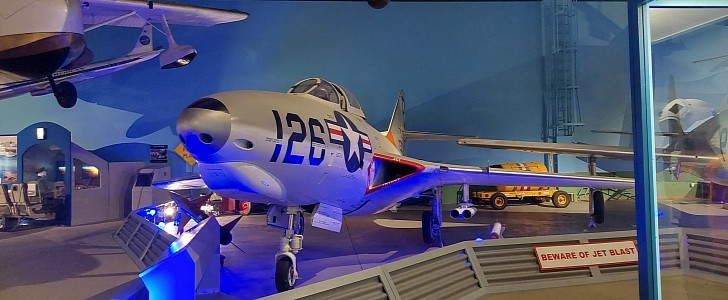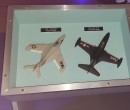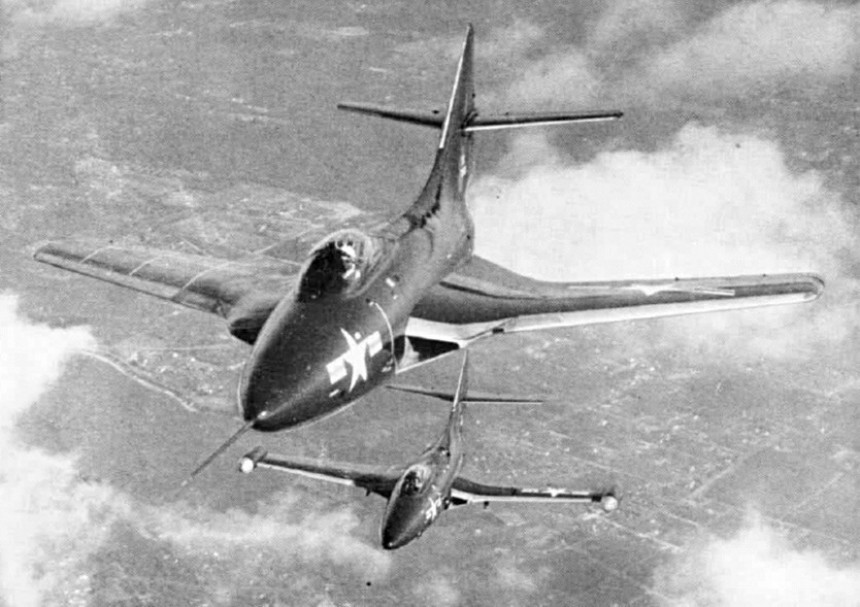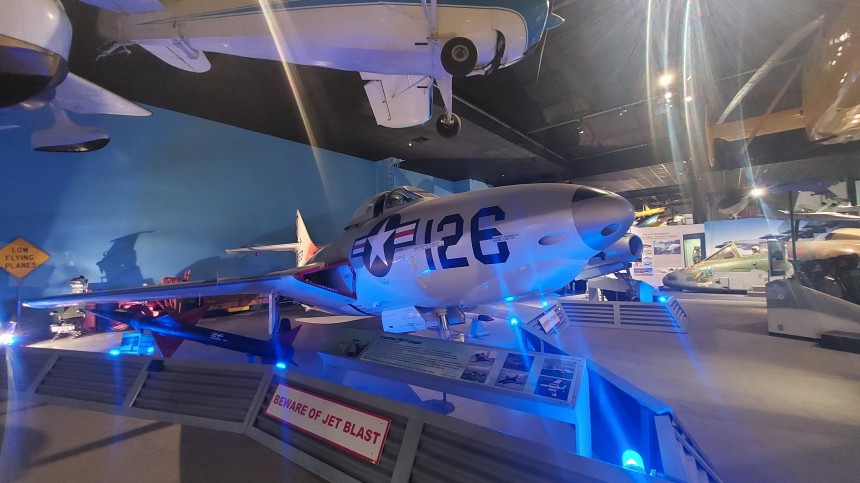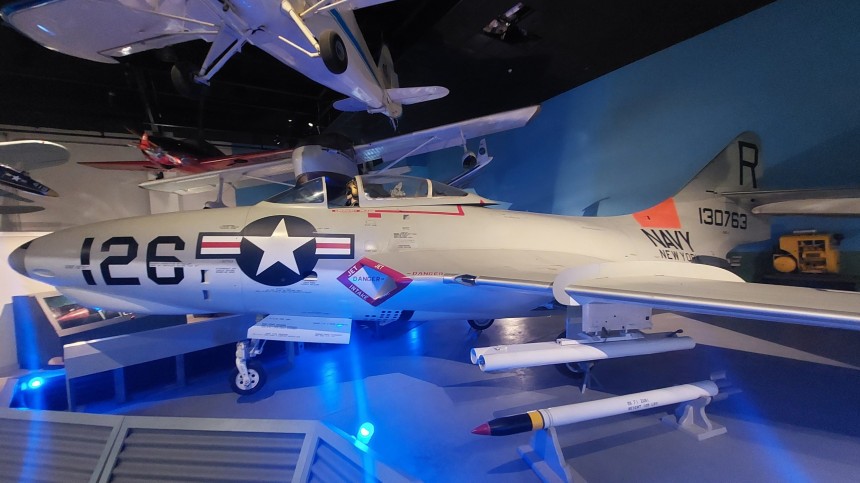The Mikoyan-Gurevich MiG-17 gave the U.S. Air Force all the hell they could handle throughout multiple conflicts across multiple decades. In its day, countless top-of-the-line American fighter jets fell at its hands.
But there's something profoundly disappointing about an American warplane designed to tussle with a Cold War Soviet MiG that never gets the chance at so much as good missile tone. This is the story of the Grumman F9 Cougar, the U.S. Navy juggernaut that never so much as sniffed a MiG's exhaust.
Grumman Aerospace Corporation of Bethpage on Long Island, New York, was the U.S. Navy's preferred source for quality built, durable, and powerful fighter planes from the days before the Second World War up until its absorption by Northrop Aviation into Northrop Grumman in the mid-1990s. In between those two points, Grumman was right on the pulse of aviation technology.
Along with Lockheed, North American, Curtiss Wright, and fellow Long Islanders at Republic Aviation, Grumman was among some of the first American contractors to get their hands on exciting new German jet engine technology. This bountiful post-WWII plunder of German engineering helped bring rise to some of the first operational American jet fighters. Among these ranks included the North American F-86 Saber, the Republic F-84 Thunderjet, and the F9 Cougar's direct forbearer, the F9F Panther.
Over the skies of Korea, the F9F Panther gained a reputation as a sturdy, durable, and surprisingly maneuverable straight-winged, carrier-based jet fighter. With a powerful Pratt & Whitney J48 turbojet engine in tow, the Panther was the premier fighter of the United States Navy during the Korean War years of 1950 to 1953.
The Panther was even the jet fighter of choice for a pre-covered-in-moon-dust Neil Armstrong during the war. Astronaut John Glenn and Major League Baseball legend Ted Williams also took the stick in the F9F. Safe to say, the Panther was more or less beloved by all who flew it. Even so, the Panther was outmatched by North Koreans flying the Russian-built Mikoyan Gurevich MiG-15.
With triple asymmetrically-sized cannons as armament, swept wing agility, and the occasional Russian pilot at the controls in secret, the Panther saw itself on the losing side of affairs more often than not. Granted, that's despite performing admirably enough in a few dogfight instances. Over the skies of the 38th Parallel, the North American F-86 Saber carried the U.S. Air Force against the MiG-15. But the Navy and Marine Corps were still in desperate need of a countermeasure.
There were indeed other options than Grumman available to design and build an equal opposing force to the mighty MiG-15. Firms like Mcdonnell with their F2H Banshee and Douglas with their F3D Skynight also had experience building Cold War Navy jets. Ultimately, it was Grumman that got the call from the Pentagon to start work on a swept wing, high-subsonic enhancement package based on the F9F Panther platform.
Meanwhile, over in the CCCP, the MiG-15, whose unfortunate NATO callsign we will not mention here, was undergoing a metamorphosis of its own. The MiG-17 (NATO Codename: Fresno) was birthed from the proverbial rib of the previous MiG-15. With improved aerodynamics, cockpit avionics, and a more powerful Klimov VK-1F turbojet engine with an afterburner, it was the most potent Soviet fighter in its arsenal in its heyday.
It also packed a serious punch, with twin 23 mm autocannons complimenting a single 37 mm autocannon. In later years, some even flew with Kaliningrad K-5 air-to-air missiles under their wing pylons. So then, Grumman's new Navy fighter had to be pretty darn good. Happily, the results of their labor, the F9 Cougar, looked up to the job.
For how advanced the MiG-17 Fresco's Klimov engine may have been, Grumman Cougar's license-built copy of the British Rolls-Royce Nene turbojet engine was equally up to the job. Dubbed the General Electric J42, the first 30 prototypes and early operational Cougars used this configuration. In later models, the General Electric/Allison J33 engine, similar to the ones used in the Lockheed P80 Shooting Star and F-94 Starfire, were implemented.
With newly developed thick swept wings, the Cougar could reach Mach 1.2 in a steep dive. It also had a weapons array of four 20 mm AN/M3 autocannons to play with. In most measurable metrics, Cougar stood toe to toe with the MiG-17. In terms of speed and weaponry, but possibly not maneuverability, it was a dead even match, at least on paper.
Like the Fresco, the Cougar carried Aim-9 Sidewinder air-to-air-missiles in its later stages of development. From an outsider's perspective, it may appear like an inevitable epic battle of titans between the MiG Fresco and the Grumman Cougar was due. That is, if not for one small hiccup. The Korean War was over before the two could properly square up with one another.
Though the MiG-17 went on to serve admirably with non-Soviet communist nations like Cuba, North Vietnam, North Korea, Cuba, Romania, and Hungary, among others, the American Cougar was quickly superseded by more advanced supersonic jet fighters. The only record of a Cougar variant serving in any armed conflict is a handful of F9F-8T twin-seaters over Vietnam. There, the type served mostly as a forward command and targeted airstrike coordinator airplane instead of an out-and-out fighter jet.
Alas, there's no credible evidence that any Cougar ever saw air-to-air combat. Today, you can see Cougars in person at dozens of locations in the U.S. and Argentina. This Particular F9F-7 serial number 130763 is on display in the Cradle of Aviation Museum in its jet age section in Garden City, New York.
Not all that far away from the factory that spawned the plane in the first place. After years sitting at the Naval Firefighting School at Lakhurst Navail Air station, it's had a full restoration and looks super wicked in Naval Reserve Squadron markings. Go ahead and check out our entire visit to the Cradle of Aviation Museum right here on autoevolution.
Grumman Aerospace Corporation of Bethpage on Long Island, New York, was the U.S. Navy's preferred source for quality built, durable, and powerful fighter planes from the days before the Second World War up until its absorption by Northrop Aviation into Northrop Grumman in the mid-1990s. In between those two points, Grumman was right on the pulse of aviation technology.
Along with Lockheed, North American, Curtiss Wright, and fellow Long Islanders at Republic Aviation, Grumman was among some of the first American contractors to get their hands on exciting new German jet engine technology. This bountiful post-WWII plunder of German engineering helped bring rise to some of the first operational American jet fighters. Among these ranks included the North American F-86 Saber, the Republic F-84 Thunderjet, and the F9 Cougar's direct forbearer, the F9F Panther.
Over the skies of Korea, the F9F Panther gained a reputation as a sturdy, durable, and surprisingly maneuverable straight-winged, carrier-based jet fighter. With a powerful Pratt & Whitney J48 turbojet engine in tow, the Panther was the premier fighter of the United States Navy during the Korean War years of 1950 to 1953.
With triple asymmetrically-sized cannons as armament, swept wing agility, and the occasional Russian pilot at the controls in secret, the Panther saw itself on the losing side of affairs more often than not. Granted, that's despite performing admirably enough in a few dogfight instances. Over the skies of the 38th Parallel, the North American F-86 Saber carried the U.S. Air Force against the MiG-15. But the Navy and Marine Corps were still in desperate need of a countermeasure.
There were indeed other options than Grumman available to design and build an equal opposing force to the mighty MiG-15. Firms like Mcdonnell with their F2H Banshee and Douglas with their F3D Skynight also had experience building Cold War Navy jets. Ultimately, it was Grumman that got the call from the Pentagon to start work on a swept wing, high-subsonic enhancement package based on the F9F Panther platform.
Meanwhile, over in the CCCP, the MiG-15, whose unfortunate NATO callsign we will not mention here, was undergoing a metamorphosis of its own. The MiG-17 (NATO Codename: Fresno) was birthed from the proverbial rib of the previous MiG-15. With improved aerodynamics, cockpit avionics, and a more powerful Klimov VK-1F turbojet engine with an afterburner, it was the most potent Soviet fighter in its arsenal in its heyday.
For how advanced the MiG-17 Fresco's Klimov engine may have been, Grumman Cougar's license-built copy of the British Rolls-Royce Nene turbojet engine was equally up to the job. Dubbed the General Electric J42, the first 30 prototypes and early operational Cougars used this configuration. In later models, the General Electric/Allison J33 engine, similar to the ones used in the Lockheed P80 Shooting Star and F-94 Starfire, were implemented.
With newly developed thick swept wings, the Cougar could reach Mach 1.2 in a steep dive. It also had a weapons array of four 20 mm AN/M3 autocannons to play with. In most measurable metrics, Cougar stood toe to toe with the MiG-17. In terms of speed and weaponry, but possibly not maneuverability, it was a dead even match, at least on paper.
Like the Fresco, the Cougar carried Aim-9 Sidewinder air-to-air-missiles in its later stages of development. From an outsider's perspective, it may appear like an inevitable epic battle of titans between the MiG Fresco and the Grumman Cougar was due. That is, if not for one small hiccup. The Korean War was over before the two could properly square up with one another.
Alas, there's no credible evidence that any Cougar ever saw air-to-air combat. Today, you can see Cougars in person at dozens of locations in the U.S. and Argentina. This Particular F9F-7 serial number 130763 is on display in the Cradle of Aviation Museum in its jet age section in Garden City, New York.
Not all that far away from the factory that spawned the plane in the first place. After years sitting at the Naval Firefighting School at Lakhurst Navail Air station, it's had a full restoration and looks super wicked in Naval Reserve Squadron markings. Go ahead and check out our entire visit to the Cradle of Aviation Museum right here on autoevolution.
